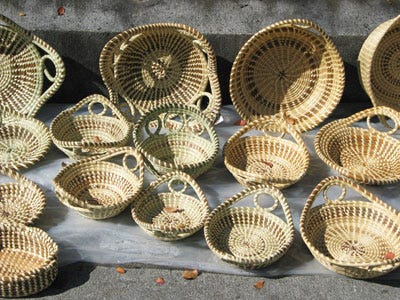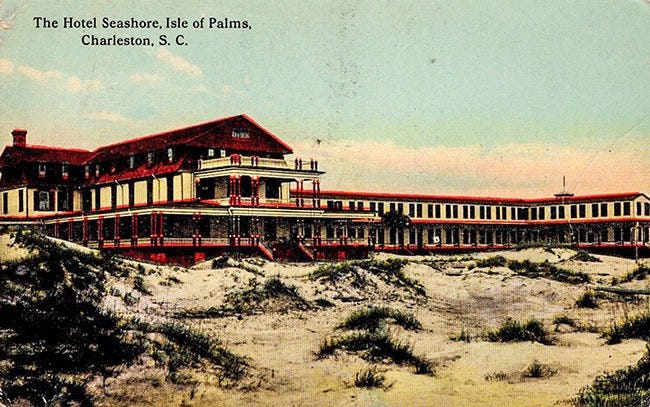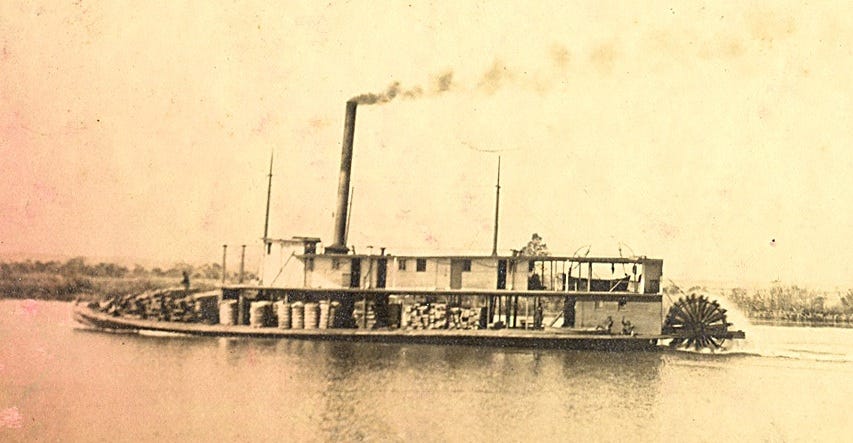#152: Salt Air & Sanctuary: Old-Time Vacations on the Carolina Coast + a Historic Horseshoe History Tour at USC
For South Carolina history lovers far and wide! Published weekly on Monday mornings. Enjoy weekly SC history articles, upcoming SC historical events, and other South Carolina recommendations.
Dear readers,
I hope everyone is staying cool in this heat!
In fact, this time of year always inspires me to want to know more about how South Carolinians survived before air conditioning — phew!
A few weeks ago, we metaphorically traveled to South Carolina’s early mineral spring spas, and this week we are traveling back in time to when the first families began building their summer retreats on Pawleys Island, Sullivan’s Island, and Isle of Palms. Enjoy!
Sincerely,
Kate
(Writing from Greenville, SC)
P.S. Be sure to get your American-history inspired iced teas from our sponsor Oliver Pluff this week for your upcoming July 4th celebrations!
Support the SC History Newsletter by considering heritages teas (inspired by South Carolina and American history!) from our fantastic sponsor Oliver Pluff & Co. — click on their beautiful ad below! :)
➳ Housekeeping for new subscribers!
New friends! There are over 100 previous SC History newsletters on topics ranging from the founding of Charleston, sunken Confederate submarines, railroad tunnels filled with blue cheese, and more! See our archive here!
Send me your comments or topic ideas: I love it when subscribers write to me! Have a SC History topic or question you’d like for me to write about? Have additional ideas or feedback? Just reply to this email and let me know!
Join us on social: Keep the conversation going and join over 100 other subscribers by becoming a member of our SC History Newsletter Facebook Community here!
If your email “cuts off”: In your email app or website, if my emails “cut off” for you, please click the title of the email and it will take you to the full post on the Substack. I don’t want you to miss any content!
Love the SC History Newsletter? Please click the button below to share with a friend!
➳ Featured Upcoming SC History Events
📜 The Good, the Bad & the Naked of USC History: Historic Horseshoe History Tour
🗓️ Thursday, July 10th, 12 - 1 pm
📝 South Caroliniana Library, 910 Sumter Street
📍Columbia, SC
💻 Website
From the event website:
“Have you ever been strolling along the Historic Horseshoe bricks and found yourself wondering about the history of Carolina and its traditions? Well, you're in luck! Meet University Archivist Elizabeth West in front of the Caroliniana Library for a Horseshoe history tour. Learn the origins of the Tiger Burn and what national record Gamecock students set in 1974! Free and open to the public.”

➳ 🗓️ Paid subscribers get access to my SC History Events Calendar that organizes all the upcoming SC history events I have discovered. Please let me know if you’d like to add an event to the calendar! Reply to this email to send me your events.
➳ Salt Air & Sanctuary: Old-Time Vacations on the Carolina Coast
In the sweltering heat of the South Carolina summer, long before the luxury of air conditioning or insect repellent sprays, the scent of salt air carried with it a promise of relief, healing, and escape.
From the late 18th century through the Gilded Age, the barrier islands dotting South Carolina’s coast — Pawleys Island, Sullivan’s Island, and Isle of Palms among them — offered refuge to Lowcountry families fleeing the suffocating “miasma” of inland plantations and the dangers of mosquito-borne disease. These island retreats were not merely picturesque getaways — they were family sanctuaries where memories were made on beaches and shaded porches in the quiet rituals of the Southern elite.
In the story of South Carolina’s earliest beach vacations, when disease and heat were loathed and feared, the ocean offered more than recreation — it was a cure.
🌿 "Escaping the Miasma"
To understand the appeal of South Carolina’s coast in the 1800s, one must first grasp the true threat of summer in the South. The word “malaria” comes from the Italian for “bad air,” and in the antebellum Lowcountry, bad air — or miasma — was thought to spread disease. While science had not yet confirmed that mosquitoes transmitted malaria and yellow fever, personal experience confirmed what generations already knew: the summer heat brought sickness inland.
Plantation owners and Charleston’s wealthier residents therefore developed a seasonal ritual: they fled the rice swamps, the marshy backwaters, and the steamy inland towns in late May or early June, returning only when the first frost had safely killed off the summer's buzzing clouds of danger.
Some fled to inland mineral springs resorts (see SC History Newsletter #150!) and summer homes, while others went to northern states to enjoy even cooler climes. Today, we will discuss the South Carolina elite who went to the sea — a tradition that continues to this day.
🏝️ Pawleys Island: “Arrogantly Shabby” Since the 1700s
Often considered one of the first true summer resorts in the United States, Pawleys Island became a seasonal haven as early as the late 1700s. Just a slender barrier island flanked by tidal creeks and the Atlantic, Pawleys offered breeze-cooled respite from Georgetown’s brutal summers. It was accessible only by boat or wooden cart roads, and it had no grand hotels — only modest weather-worn beach houses built by the Lowcountry planter class. The island was named after Percival Pawley, who was the first European settler to develop plantations in the area, dating back to 1711.

Life on Pawleys was simple by design. There were few commercial enterprises and even fewer distractions. Families passed their days crabbing in the marshes, reading in shaded hammocks, swimming in the surf, and gathering each evening for supper. The architecture of Pawleys reflected this rhythm — wide porches and open designs to let the wind flow through. Most homes had no insulation and certainly no air conditioning.
The Gullah community, descended from enslaved Africans, played an essential role in the life and labor of these summer escapes. Many Gullah people worked as nannies, cooks, and boatmen during the summer season, and their rich traditions —storytelling, basket weaving, cuisine — quietly infused the Pawleys atmosphere with cultural depth. Much of the land they inhabited during and after Reconstruction remains part of the island’s story today.

To this day, Pawleys is proud of its unofficial slogan: “Arrogantly shabby.” The island’s refusal to modernize is part of its charm. It retains a sleepy dignity—rooted in pine-scented traditions that outlived the railroads and the rise of Myrtle Beach resorts just to the north.

🪟 Sullivan’s Island: Sea Breezes and Escaping Yellow Fever
Charleston, meanwhile, looked to Sullivan’s Island as its traditional escape. Since colonial times, Sullivan’s had a military identity — home to Fort Moultrie and a line of watch posts guarding the Charleston harbor. But it also evolved into a civilian haven, particularly during yellow fever outbreaks in the 18th and 19th centuries. The island was first discovered in 1666 by Captain Robert Sandford and named for one of South Carolina’s first colonists, a former Irish soldier named Captain Florence O’Sullivan.
Sullivan’s Island was considered beyond the reach of the deadly disease. The salt air was thought to “cleanse the lungs,” and the constant breeze kept mosquitoes at bay. In time, it became so accepted as a health sanctuary that physicians prescribed trips to the island.
By the 1820s, the Sullivan’s Island ferry began regular service, shuttling families across the harbor for the summer season. By the late 1800s, the island had developed a string of summer cottages — mostly one or two-story wooden homes elevated on pilings to resist floods. Some homes still stand today. The long-lost carriage paths turned into sandy streets.

Sullivan’s was also a writer’s muse. Edgar Allan Poe was stationed at Fort Moultrie in the 1820s, and his story “The Gold-Bug” is set on the island. Legend has it he wandered its dunes and used local names in his stories, leaving behind not only literature, but a mysterious romantic legend of a young woman he fell in love with there.
By the early 20th century, Sullivan’s Island was no longer the exclusive retreat of Charleston’s elite, but a lively, eclectic mix of beachgoers, artists, and families — many of whom came not for health, but for tradition.
🏖️ Isle of Palms: The Birth of the Resort Beach
While Pawleys and Sullivan’s were family-oriented summer escapes with minimal development, the Isle of Palms took a more commercial direction. Known in the late 19th century as “Hunting Island” or “Long Island,” the barrier island was transformed in the 1890s by a group of developers who envisioned a full-fledged seaside resort — complete with hotels, a boardwalk, and an amusement pavilion.
In the amusement pavilion, there was a “Ferris wheel, a merry-go-round and a restaurant on the island that served a meal for 50 cents.” Some accounts say that the Ferris wheel at the Island of Palms was the biggest in the world at the time.

The New York Herald published this poem from an awestruck beachgoer seeing the Ferris wheel for the first time:
If I dispatch the mind ever so gently
To yesterday, I can embrace you now;
And with lids closed, to visit you more clearly,
O towering skeleton, I chant this vow
That all my life I shall demand to see you
Shall turn with you and almost touch the sky;
Below a vast immeasurable blue,
The trackless dunes…Time’s mutability!Embark to an Arcadian past again
And share the wonder of a miracle;
A giant wheel upon a sandy plain.
Across the bay St. Michael’s tower gleams.
Majestic oaks await no oracle—
No intervals of change attack my dreams
With the help of the Charleston and Seashore Railroad, which brought vacationers from downtown Charleston straight to the island, the Isle of Palms became accessible to a broader audience. The local newspaper read on July 26, 1898:
“A great event for the city, the Seashore Road formally opened yesterday. When the Commodore Perry left the new dock of the Charleston Seashore and Railway Company at 9 o’clock yesterday afternoon her spacious deck was crowded with people, all anxious to be among the first to visit that, as yet, unknown country, stretching vaguely behind the familiar shores of Mount Pleasant and Sullivan’s Island. The Sappho, her deck also crowded with people, and the Pocosin, not so well patronized, steamed out of their docks just a moment before.”
The first hotel on Isle of Palms, the Seashore Hotel, opened in 1906 and boasted 150 rooms, modern plumbing, and electric lights — a far cry from the rustic retreats of earlier generations.

For many South Carolinians, Isle of Palms became a symbol of modern summer leisure: dancing, dining, and swimming, no longer cloaked in the medicinal justifications of earlier seaside escapes. It was a place for courtship, celebration, and communal enjoyment — a democratic expansion of what had once been a more exclusive tradition.
🚂 The Journey to the Shore
Getting to the coast in the 1800s was no small feat. While some families had summer homes they returned to year after year, others rented cottages or stayed in inns. Travel often involved steamboats down the Waccamaw River or train rides from the interior to Georgetown or Charleston, followed by buggy or ferry transfers to the islands.

The discomfort of travel only reinforced the season’s importance. Once families arrived, they tended to stay the entire summer — sending fathers back to the city during the work week while mothers, children, and domestic staff (including enslaved nannies and workers) remained at the beach.
On that note, it must be said that for Southern elite who did own enslaved workers, those populations remained on the inland plantations in the height of the malarial summers:
“The long days and hot sun of the summer months contributed to making it the most grueling season for slaves. Rice fields were continually hoed from June through August. Some slaves were forced to wade waist deep in water for hours to stave off birds while others remained on their hands and knees picking weeds and grass from the soil. On tobacco plantations, slaves spent the summer months transplanting tobacco plants and removing ground worms and caterpillars.”
🍉 Rituals of Coastal Living
Life on the coast followed a familiar seasonal script. Mornings were often reserved for ocean bathing, believed to invigorate the body and soul.
Afternoons involved reading, sewing, or napping in the shade. Dinners featured fresh fish, local melons, and cornmeal dishes, often prepared by enslaved cooks whose recipes are still embedded in Lowcountry cuisine today.

Mosquito nets draped over iron bed frames. Families bounced on joggling boards on breezy porches. Visitors left calling cards in the parlor and wrote long letters describing the sea breeze and the antics of children wading in the surf. For these families, the ocean was a place of retreat, healing, and ritual.
🌊 Modern Transformation
By the mid-20th century, the nature of coastal vacationing changed dramatically. The rise of air conditioning, insect control, and automobiles made inland living more tolerable and travel more accessible. Commercial development also transformed the quiet beaches of the 19th century into hubs of activity. Myrtle Beach rose to prominence with its golf courses and neon lights, while islands like Kiawah and Seabrook became exclusive resort enclaves.
And yet, traces of the old rituals remain.
At Pawleys, families still return to the same beach houses each summer, many passed down for generations. On Sullivan’s Island, cool ocean breezes still flow through airy porches. While the memories of simpler times past might have become quieter, they are not forgotten.
If you voted just “OK” on the newsletter today, I want to hear from you! Reply to this email and send me your feedback. :)
➳ Sources — Salt Air & Sanctuary: Old-Time Vacations on the Carolina Coast
“About Pawleys Island.” Town of Pawleys Island, https://www.townofpawleysisland.com/about-pawleys-island/. Accessed 29 June 2025.
“Charleston’s Long History of Quarantining.” Charleston Magazine, https://charlestonmag.com/features/charlestons_long_history_of_quarantining. Accessed 29 June 2025.
“Fighting Illness at Sullivan’s Island Pest House.” Post and Courier, https://www.postandcourier.com/moultrie-news/opinion/fighting-illness-at-sullivans-island-pest-house/article_75528b6b-12dc-562d-8cba-65cd8816189b.html. Accessed 29 June 2025.
“Fort Moultrie.” National Park Service, https://www.nps.gov/fosu/learn/historyculture/fort_moultrie.htm. Accessed 29 June 2025.
“Historic Epidemics in Charleston.” Charleston Raconteurs, https://www.charlestonraconteurs.com/historic-epidemics.html. Accessed 29 June 2025.
“Isle of Palms History.” Isle of Palms Property, https://www.isleofpalmsproperty.net/the-history-of-isle-of-palms-sc/. Accessed 29 June 2025.
“Isle of Palms, South Carolina.” Wikipedia, https://en.wikipedia.org/wiki/Isle_of_Palms,_South_Carolina. Accessed 29 June 2025.
“Island History.” I Love IOP, https://iloveiop.com/isle-of-palms-sc/2010/island-history/isle-of-palms-history-77/. Accessed 29 June 2025.
“On the Hunt for Heirloom Watermelon.” Garden & Gun, https://gardenandgun.com/articles/on-the-hunt-for-heirloom-watermelon/. Accessed 29 June 2025.
“Quarantine in Charleston Harbor, 1698–1949.” Charleston Time Machine, Charleston County Public Library, https://www.ccpl.org/charleston-time-machine/quarantine-charleston-harbor-1698-1949. Accessed 29 June 2025.
“Raising History: The Story of a Historic Sullivan’s Island House That Has Evolved with Its Owners.” Charleston Magazine, https://charlestonmag.com/features/raising_history_the_story_of_a_historic_sullivan_s_island_house_that_has_evolved_with_its. Accessed 29 June 2025.
“Seasonal Rhythms of Life.” Encyclopedia.com, https://www.encyclopedia.com/humanities/applied-and-social-sciences-magazines/seasonal-rhythms-life. Accessed 29 June 2025.
“Steamboats: A New Exhibit.” South Carolina Maritime Museum, https://scmaritimemuseum.org/steamboats-a-new-exhibit/. Accessed 29 June 2025.
“Street Cars and Trolleys to Sullivan’s Island, 1875–1927.” Charleston Time Machine, Charleston County Public Library, https://www.ccpl.org/charleston-time-machine/street-cars-and-trolleys-sullivans-island-1875-1927#_ednref2. Accessed 29 June 2025.
“Sullivan’s Island.” South Carolina Encyclopedia, https://www.scencyclopedia.org/sce/entries/sullivan%C2%92s-island/. Accessed 29 June 2025.
“Sullivan’s Island Historic District.” Wikipedia, https://en.wikipedia.org/wiki/Sullivan%27s_Island_Historic_District. Accessed 29 June 2025.
“The Surf-Bathing Craze at Sullivan’s Island.” Charleston Time Machine, Charleston County Public Library, https://www.ccpl.org/charleston-time-machine/surf-bathing-sullivans-island-19th-century. Accessed 29 June 2025.
“What Is Pawleys Island Known For?” PawleysIsland.com, https://www.pawleysisland.com/faq/. Accessed 29 June 2025.
Schaw, Janet. Journal of a Lady of Quality: Being the Narrative of a Journey from Scotland to the West Indies, North Carolina and Portugal in the Years 1774 to 1776, edited by Evangeline Walker Andrews, University of North Carolina at Chapel Hill, https://docsouth.unc.edu/nc/schaw/schaw.html. Accessed 29 June 2025.












